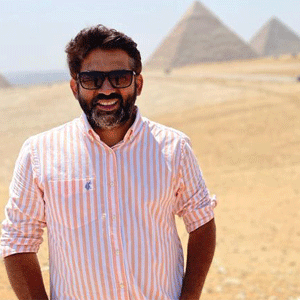 The position of Chief Technology Officer has grown even more crucial with the continued development of software and the introduction of more sophisticated features like artificial intelligence. A CTO must make sure that their vision pushes the business in the direction of a more competitive position in the market. CTOs must not only be up-to-date on the most recent innovations but also foresee where technology is headed and make sound future plans.
The position of Chief Technology Officer has grown even more crucial with the continued development of software and the introduction of more sophisticated features like artificial intelligence. A CTO must make sure that their vision pushes the business in the direction of a more competitive position in the market. CTOs must not only be up-to-date on the most recent innovations but also foresee where technology is headed and make sound future plans.Karan Mehta, founder, and chief technology officer of RING, introduced a made-in-India online instant credit platform operated by On EMi Technology Solutions in an effort to provide their coveted product to customers across India. RING is conceived to provide its customers with an instant credit facility. In addition, it permits the customer to enter any merchant store that accepts payments from UPI apps such as BHIM, PHONEPE, Paytm, Freecharge, Mobikwik, Axis Pay, Jio Pay, and more. This revolutionary product, aptly named the RING Limit, allows customers to make purchases at any merchant store of their choosing with the RING credit line, which must be repaid within the specified time frame.
CIO TechOutlook India is delighted to engage in an exclusive interview with Karan Mehta.
How do you view the evolving role of the CTO in today's business? And what are the primary causes of this transformation?
It's interesting to see how the role of a CTO has evolved in today's enterprise. While the CTO has always been responsible for technology decisions, the changing business environment has added two additional dimensions to the role. Firstly, a CTO now needs to have a product-focused mindset and understand how technology decisions impact product development. Secondly, a CTO needs to have a customer-centric lens and understand how customer expectations shape technology decisions. Finally, a CTO needs to ensure that technology decisions align with the overall business strategy of the company. All of these factors have made the role of a CTO more complex and multi-dimensional than it has been in the past. Ultimately, the CTO needs to be able to balance all of these different responsibilities in order to ensure the success of the organization.
What strategic obstacles do CTOs typically face when identifying and implementing new technologies that could be advantageous to their organization? How did you overcome these obstacles?
To overcome these challenges, I ensure that we are always running at a higher engineering bandwidth than required for current projects so that we can allocate a portion of that toward future-looking projects.
Additionally, we prioritize projects that have a direct impact on the business while also ensuring that we allocate enough resources towards research and development for futurelooking projects. We also have a culture of constantly learning and staying up-to-date with new technologies, which helps us identify new tools and technologies that could benefit our organization. Overall, the key is to strike a balance between short-term and long-term goals and to make strategic decisions that will benefit the organization in the long run.
What role are you playing as a leader in the strategy to adopt technology for RING?
I've taken a balanced approach to lead the technology adoption strategy for RING. By hiring sharp minds on the engineering and product sides and empowering them to make customer-centric decisions while also keeping business requirements in mind, I've created a culture of innovation and adaptability within the organization. Additionally, I've made sure to invest in forward-looking technologies while also ensuring that my tech stack is always up-to-date and meeting the needs of the business.
How can you strike a balance between developing new features and fixing bugs in older programs? What difficulties do you encounter in doing so?
Yes, keeping a tech debt backlog and having every team pick up at least ten percent of tickets on the backlog each sprint is a good approach to continuously iterate upon the existing system and make necessary improvements. It's great that our company has been able to re-architecture its system multiple times without disrupting the entire system. By continuously making small fixes and improvements, our company has been able to keep up with the changing technology landscape and maintain a system that we are happy with. This approach also allows for faster feedback loops and ensures that any issues or inefficiencies are addressed in a timely manner. Overall, RING has found a good balance between innovation and maintaining legacy systems.
How do you create your company's technology roadmap and align it with its goals?
I have a very collaborative approach to building the technology roadmap and staying up-to-date with new developments in the industry. I think it's important for a CTO to remain hands-on with technology, even if they are no longer coding full-time, so they can continue to lead by example and inspire their team to stay curious and always be learning. I also think one should have a clear vision for the company's goals and can work with their team to align the technology roadmap with the vision. It's important to have a roadmap that is both forward-looking and realistic, taking into account the resources and capabilities of the team.
What role are you playing as a leader in the strategy to adopt technology for RING?
I've taken a balanced approach to lead the technology adoption strategy for RING. By hiring sharp minds on the engineering and product sides and empowering them to make customer-centric decisions while also keeping business requirements in mind, I've created a culture of innovation and adaptability within the organization. Additionally, I've made sure to invest in forward-looking technologies while also ensuring that my tech stack is always up-to-date and meeting the needs of the business.

RING has found a good balance between innovation & maintaining legacy systems
How can you strike a balance between developing new features and fixing bugs in older programs? What difficulties do you encounter in doing so?
Yes, keeping a tech debt backlog and having every team pick up at least ten percent of tickets on the backlog each sprint is a good approach to continuously iterate upon the existing system and make necessary improvements. It's great that our company has been able to re-architecture its system multiple times without disrupting the entire system. By continuously making small fixes and improvements, our company has been able to keep up with the changing technology landscape and maintain a system that we are happy with. This approach also allows for faster feedback loops and ensures that any issues or inefficiencies are addressed in a timely manner. Overall, RING has found a good balance between innovation and maintaining legacy systems.
How do you create your company's technology roadmap and align it with its goals?
I have a very collaborative approach to building the technology roadmap and staying up-to-date with new developments in the industry. I think it's important for a CTO to remain hands-on with technology, even if they are no longer coding full-time, so they can continue to lead by example and inspire their team to stay curious and always be learning. I also think one should have a clear vision for the company's goals and can work with their team to align the technology roadmap with the vision. It's important to have a roadmap that is both forward-looking and realistic, taking into account the resources and capabilities of the team.





